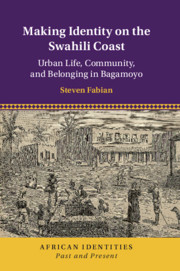Book contents
- Making Identity on the Swahili Coast
- African Identities: Past and Present
- Making Identity on the Swahili Coast
- Copyright page
- Dedication
- Contents
- Illustrations
- Preface
- A Note on Spellings and Currency
- A Note on Nomenclature
- Abbreviations
- Maps
- Introduction
- Part One Becoming Bagamoyo
- 1 Owners of the Town
- 2 Owners of the Town
- 3 Becoming Wabagamoyo
- Part Two Fitting into their Way of Life: Local Community and Colonial Control
- Epilogue
- Glossary
- Select Bibliography
- Index
3 - Becoming Wabagamoyo
A Local Vocabulary for a Swahili Town
from Part One - Becoming Bagamoyo
Published online by Cambridge University Press: 28 October 2019
- Making Identity on the Swahili Coast
- African Identities: Past and Present
- Making Identity on the Swahili Coast
- Copyright page
- Dedication
- Contents
- Illustrations
- Preface
- A Note on Spellings and Currency
- A Note on Nomenclature
- Abbreviations
- Maps
- Introduction
- Part One Becoming Bagamoyo
- 1 Owners of the Town
- 2 Owners of the Town
- 3 Becoming Wabagamoyo
- Part Two Fitting into their Way of Life: Local Community and Colonial Control
- Epilogue
- Glossary
- Select Bibliography
- Index
Summary
This chapter examines the process of how diverse societies, each who made Bagamoyo “their own,” came to recognize one another as members of a shared space. It examines the social links, networks, and exchanges which knit together a local identity based on familiarity of place and the inhabitants who dwelled there. Using a variety of cultural categories, such as religion, sports, dance, and town gossip, this chapter explores social phenomena which became part of the community lore that reinforced one’s sense of being Wabagamoyo. While Africans, Asians, and Europeans might be divided by cultural backgrounds, they could all identify themselves as Wabagamoyo through their familiarity with common local references, such as people, places, or events – the town’s shared vocabulary. Such social networks both divided town loyalties and mutually reinforced a sense of local identity. Rivalries in Bagamoyo’s history provided the bread and butter of local gossip, legend, and lore. To be a Bagamoyo “insider” was to know the local personalities and appreciate the history behind the rivalries.
- Type
- Chapter
- Information
- Making Identity on the Swahili CoastUrban Life, Community, and Belonging in Bagamoyo, pp. 120 - 172Publisher: Cambridge University PressPrint publication year: 2019

